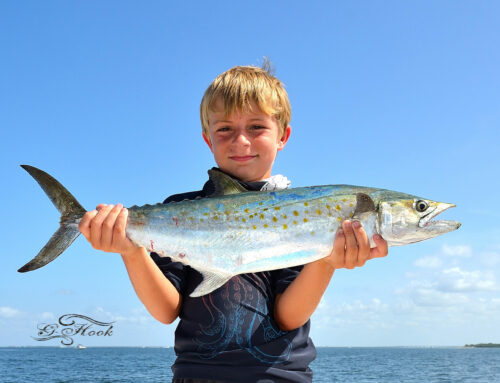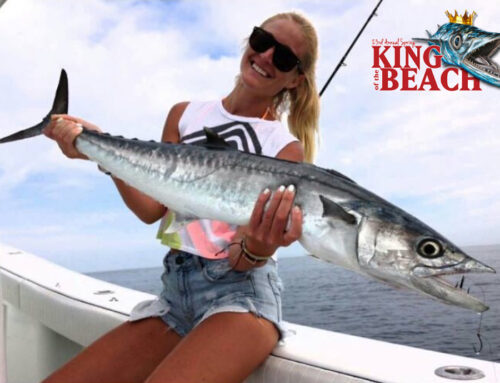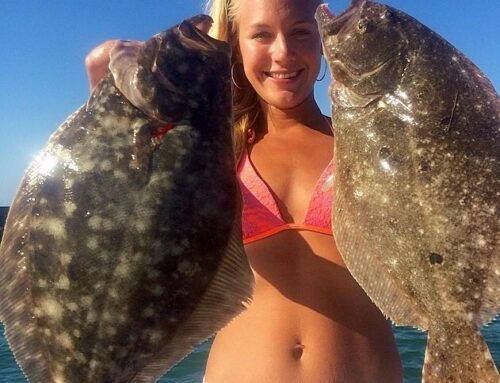It may not be pretty, but the fish with what looks like three tails is beautiful to eat, especially when preparation is kept simple.
I once overheard two anglers talking about the succulence of the tripletail. One remarked he would release a grouper and fistfight a heavyweight champ for one of these delicious fish.
The tripletail is difficult to classify in Florida’s sport fish categories. You can’t go to your local tackle shop and buy a tripletail edition rod and reel, and rarely do you see it adorning T-shirts or caps. But what the tripletail lacks in recognition, it more than makes up for on the table.
Another Gulf Coast angler once told me that you could throw a tripletail filet in the mud, drag it behind the car on the way home and it would still taste good. The point is that any cook, whether culinary novice or professional, will find tripletail easy and worthwhile to prepare.
The tripletail gets its name from its elongated dorsal and anal fins, which are almost as long as the tail fin, making it appear to have three tails. The tripletail inhabits inshore, nearshore and offshore waters and often is found near floating weed lines, crab traps, channel markers and other structure. The tripletail is found in Florida waters primarily during spring, summer and fall.
The most challenging way to catch tripletail is by sight fishing, by looking for “floating” fish – especially around weed lines or a line of lobster or crab trap buoys. Anglers aiming to land one of the tastiest fish in Florida will run on plane down trap lines looking for the telltale brown dishrag shape of a floating tripletail. I am often amazed at how tripletails seem to think they are completely hidden from predators, even though they stand out for anglers with a sharp eye. You can also catch tripletail around shallow structure, but may often be beaten to the punch by other wreck- and reef-dwelling fish.
When sight fishing for tripletail, try a live shrimp pegged to a small No. 1 or No. 2 circle hook, with a length of 20-pound fluorocarbon leader. It is usually best to approach tripletail from down current and downwind, letting the bait drift naturally toward them. Fly anglers will find tripletail a great sport fish – tough fighters on eight- or nine-weight rods. Small brown crustaceans imitating flies or naturally hued baitfish patterns will usually draw strikes.
The tripletail’s meat is white, sweet and flaky, similar to a prime rib cut of grouper. When it comes to preparing them, less is more. Simply pan sauté, broil or bake. Or, to take it to the next level, add a little butter, lemon, flat leaf parsley and freshly ground pepper – and consider pairing your tripletail entrée with a side of grilled zucchini dressed in a marinade of olive oil, fresh ground pepper and kosher salt. Resist battering or grilling the tripletail; the flavor of this savory fish can shine through on its own.
Article was found here: http://www.visitflorida.com/en-us/fishing/articles/2012/september/2323-florida-tripletail-will-more-than-double-your-dining-pleasure.html
 Congratulations to Billy Alstrom for winning the Tripletail photo of the week! What a catch and the expression on his face says it all. He caught this fish on the west coast of Florida off of Anna Maria Island under a crab bouy. She weighed 24lbs and was 31″ long with a 28 ” girth. If your wondering what he is looking at, I’m pretty sure he is thanking the lord!!
Congratulations to Billy Alstrom for winning the Tripletail photo of the week! What a catch and the expression on his face says it all. He caught this fish on the west coast of Florida off of Anna Maria Island under a crab bouy. She weighed 24lbs and was 31″ long with a 28 ” girth. If your wondering what he is looking at, I’m pretty sure he is thanking the lord!!



I once overheard two anglers talking about the succulence of the tripletail. One remarked he would release a grouper and fistfight a heavyweight champ for one of these delicious fish.
The tripletail is difficult to classify in Florida’s sport fish categories. You can’t go to your local tackle shop and buy a tripletail edition rod and reel, and rarely do you see it adorning T-shirts or caps. But what the tripletail lacks in recognition, it more than makes up for on the table.
Another Gulf Coast angler once told me that you could throw a tripletail filet in the mud, drag it behind the car on the way home and it would still taste good. The point is that any cook, whether culinary novice or professional, will find tripletail easy and worthwhile to prepare.
The tripletail gets its name from its elongated dorsal and anal fins, which are almost as long as the tail fin, making it appear to have three tails. The tripletail inhabits inshore, nearshore and offshore waters and often is found near floating weed lines, crab traps, channel markers and other structure. The tripletail is found in Florida waters primarily during spring, summer and fall.
The most challenging way to catch tripletail is by sight fishing, by looking for “floating” fish – especially around weed lines or a line of lobster or crab trap buoys. Anglers aiming to land one of the tastiest fish in Florida will run on plane down trap lines looking for the telltale brown dishrag shape of a floating tripletail. I am often amazed at how tripletails seem to think they are completely hidden from predators, even though they stand out for anglers with a sharp eye. You can also catch tripletail around shallow structure, but may often be beaten to the punch by other wreck- and reef-dwelling fish.
When sight fishing for tripletail, try a live shrimp pegged to a small No. 1 or No. 2 circle hook, with a length of 20-pound fluorocarbon leader. It is usually best to approach tripletail from down current and downwind, letting the bait drift naturally toward them. Fly anglers will find tripletail a great sport fish – tough fighters on eight- or nine-weight rods. Small brown crustaceans imitating flies or naturally hued baitfish patterns will usually draw strikes.
The tripletail’s meat is white, sweet and flaky, similar to a prime rib cut of grouper. When it comes to preparing them, less is more. Simply pan sauté, broil or bake. Or, to take it to the next level, add a little butter, lemon, flat leaf parsley and freshly ground pepper – and consider pairing your tripletail entrée with a side of grilled zucchini dressed in a marinade of olive oil, fresh ground pepper and kosher salt. Resist battering or grilling the tripletail; the flavor of this savory fish can shine through on its own.
Article was found here: http://www.visitflorida.com/en-us/fishing/articles/2012/september/2323-florida-tripletail-will-more-than-double-your-dining-pleasure.html